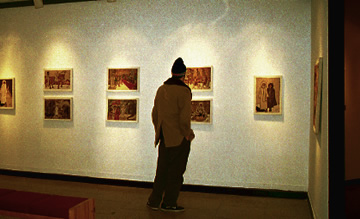February 6 marked the opening of the latest art exhibit at UMB’s Harbor Art Gallery. This particular display is dedicated to the works of acclaimed Senegalese artist Omar Diop, who works with sand as his medium, as well as several companion pieces by Mbaye LyBa (also of Senegal) that are interpretations of Diop’s work, done on a “sous-verre'”(under glass) medium. This exhibition was brought about as part of a collaboration between the UMB Africana Studies department and the University of Gaston-Berger in Saint Louis, Senegal, where Diop teaches. Diop is also an instructor within the arts component of the UMB-sponsored “Yes With Africa” program, which was initiated last year in Senegal and Benin to organize academic and social activities for young students in West Africa.
As Professor Jemadari Kamara of the Africana Studies department, who organized the exhibition explains, the various types of sand used by Diop in his images are gathered by him from natural sources throughout his homeland, and then tinted with either earth tones or more vibrant colors, depending on the subject matter of the individual piece. Mbaye LyBa’s sous-verre renditions of Diop’s pieces are hung opposite their counterparts and feature alternate color schemes and work to mirror the originals.
Among the pieces on display in the Gallery is a series of 8 works depicting the life of Sheikh Amadou Bamba, the 19th century Muslim founder of Senegal’s Murid sect, who was fabled to command great spiritual power. One of the paintings relates a story in which Bamba, when placed in a lion cage, was able to instantly tame the beasts and have them kneel and pray with him. Another part of the series has Bamba in Saint Louis, facing and resisting Senegal’s French colonial government, which claimed sovereignty over the region and tried to forcibly convert the population to Christianity. The colonists saw Bamba as a threat to their power and exiled him to Gabon under accusations of subversive action. The pieces in this series are among the more realistic of Omar Diop’s works and primarily use earth tone shades.
Another series included in the exhibit is a set of five collaborative pieces by Diop and LyBa, entitled “Sunugal” (the native name for Senegal), which features an African rowboat as its centerpiece, each being steered differently by a different set of figures, and with varying color schemes surrounding the vessel. The boat itself is meant to represent the whole of Senegal, while those rowing it, by the various details of how they are painted (i.e. the colors used and the direction in which the oars point) alternately symbolize harmony and dissonance between the people of the country. There are a total of five different renditions of this piece, each being a different interpretation of the nation’s condition.
Also on display are a number of Diop’s later, more abstract works, wherein the artist continues to base his art primarily on various aspects of his native culture. There are renditions of Ensemble Instrumental and Dancers, which depict the duality of the musical assemblage as both a single constant entity and simultaneously a collection of individuals. The Temple Guard and The Source of Knowledge are two of the more bizarre vignettes, illustrating a number of facets of Senegalese daily life with a large number of overlapping motifs and abstruse representations of both natural and man-made characteristics of the nation. Ethnic and racial discord both in West Africa and on a grand scale are also touched upon by Diop. The chaotic abstract piece Praise of Fight (Baak) has the appearance of a violent clash between Senegal’s native culture and the influence of European colonists, with money as an integral element, showing up as both Western currency and the Kaori shell (used by natives as both money and decoration and a widely recurring element among Diop’s art). The piece that represents racial strife on a macrocosmic level is called Mystical Vision, and shows a pair of faces, one white and one black, at the center, gazing in opposite directions, with different views of the future in their eyes.
As a whole, the Omar Diop/Mbaye LyBa exhibit brings to UMB a much-needed look at the native art of West Africa, and a more general view of the culture of that part of the world, which most of the university’s students know little about. With regards to the artists, it provides a great cross-section of the evolution of Diop’s work, from more realistic early pieces such as The Hairdresser to later, more transcendent pieces like Praise of Fight and The Temple Guard as well as an interesting examination of how two artists can differently relate the same scene just by changing the color scheme and medium. This display will be featured at the Harbor Art Gallery on the first floor of the McCormack building through March 5. For more information, contact Professor Kamara [[email protected]] or simply stop by the gallery itself.





















































